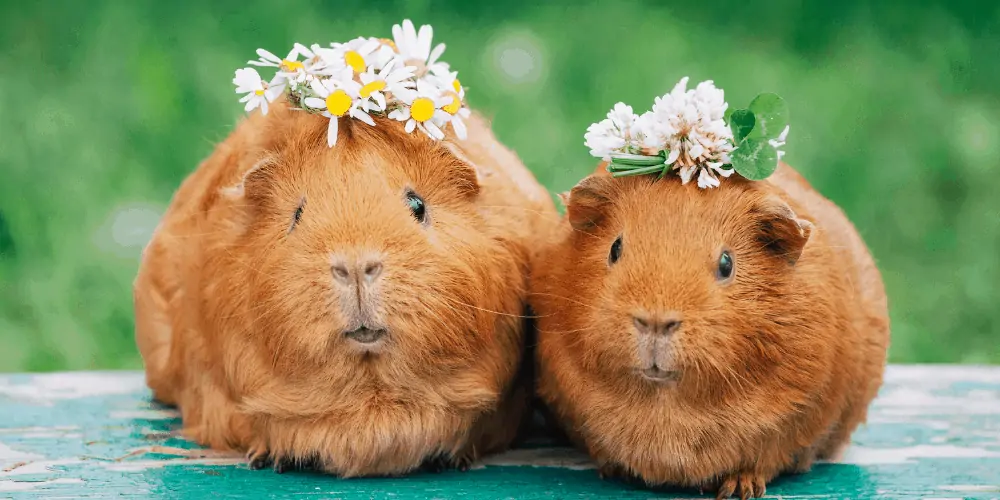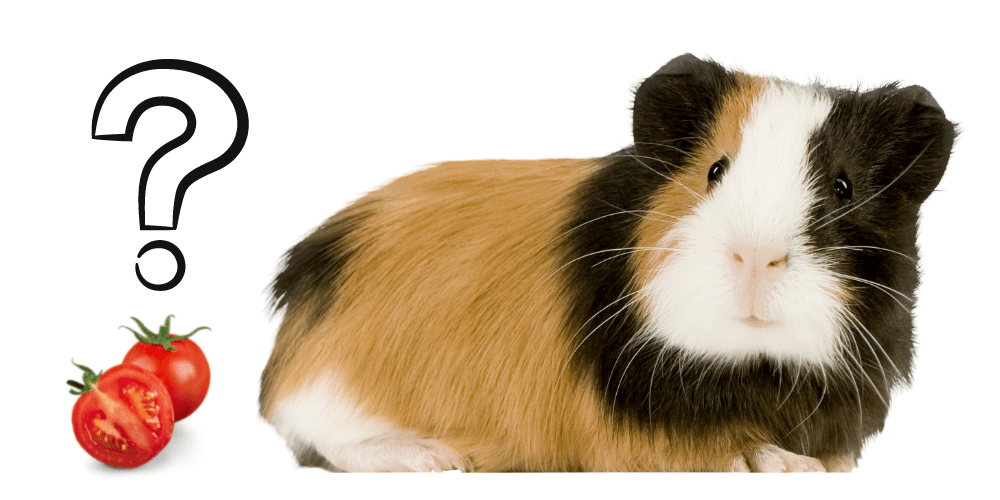I’m quite good at giving my guinea pigs a varied diet, and I try to make sure they get the right range of nutrients.
However, there were some foods I was told to avoid, and this got me wondering about what can guinea pigs eat.
A guinea pig’s main diet should be pellets and hay, with a daily portion of fruit and veg. Guinea pigs are herbivores, and so only eat vegetation, but fruit and veg should be given in moderation.
About 1 cup is a good amount; you should vary fruit and vegetables daily.
Researching what guinea pigs can eat got me thinking about the big parts of their diet: pellets and hay.
I decided to look at what are the best things to look for, and also the best range of fruit and veg to feed your guinea pig.
Read on to find out more.
What Are Guinea Pig Pellets?
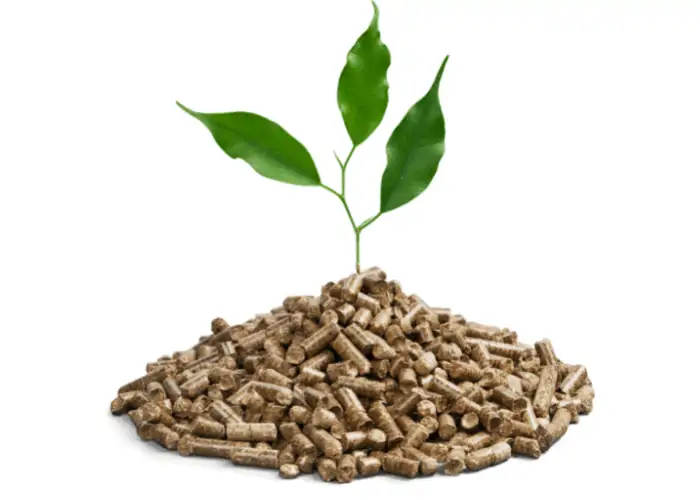
Guinea pig pellets are specially designed dried food that is perfect for guinea pigs to eat.
Guinea pig pellets are stuffed full of all the main nutritional components your guinea pig needs, including protein, fiber, vitamins, and minerals.
They should be the bulk of your guinea pig’s diet, and should be fed daily.
While this sounds great, it’s worth knowing what ingredients guinea pig pellets contain.
This way you can know what to feed your guinea pig to make sure it has a balanced diet, and that it’s not getting too much of something (such as vitamin C).
Always look for a good quality brand of guinea pig pellets, as the cheaper ones will scrimp on the ingredients.
The pellets should contain a minimum of 20% fiber and around 15-17% crude protein. Think of this as the lowest standard, and look for anything above this.
The better the pellets, the less you’ll have to worry about balancing your guinea pig’s diet.
Many brands of pellets will contain vitamin C, as this is an essential vitamin that guinea pigs are unable to produce naturally.
They need around 30mg a day, and will get some of this from the fruit and veg that you feed them.
Although it’s great if the pellets contain vitamin C, just be wary of the fact that it’s a volatile substance, meaning it expires very quickly and loses all nutritional value.
Don’t worry, the pellets themselves will be fine, they’ll just contain negligible levels of vitamin C. That’s why I use vitamin C drops in their water instead, it’s much easier.
There isn’t an exact amount for how much guinea pig pellets your pets should have every day, but some brands might print feeding guidelines.
I generally give around 6 grams of dried food for every 100g of guinea pig and this seems to do fine.
Guinea pig pellets have the correct balance of essential nutrients, vitamins, and minerals to make up a large portion of their diet.
They can get the rest of their necessary nutrients from fruit and veg, providing they’re fed a good range.
Why Hay?
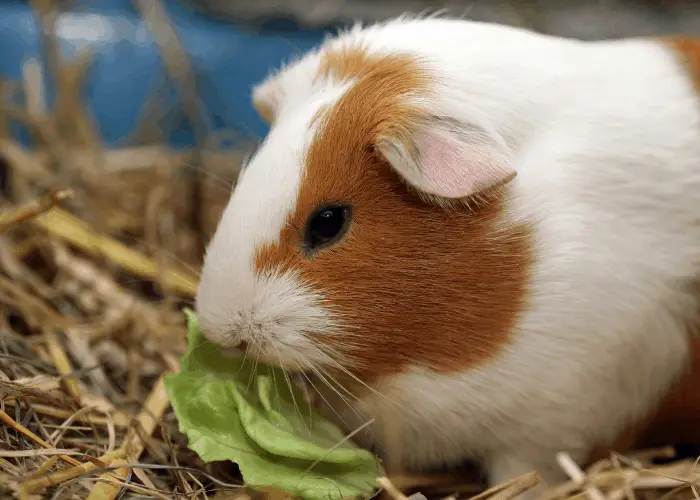
Guinea pigs also love to eat hay, and they should be given an unlimited supply for good digestion.
This doesn’t mean you’ll be constantly shoveling hay into their cages, but a good handful or two a day will be enough.
However, if they don’t have any hay left, then you should add more.
Guinea pigs need hay mainly for fiber, but it also has other essential nutrients, such as protein and vitamins and minerals.
You should look for good quality hay that’s designed for eating rather than hay that would be used as bedding.
This type of hay is dry and has little nutritional value, and too much would make your guinea pigs ill.
What Is The Best Hay For Guinea Pigs?
The main bulk of a guinea pig’s diet should be hay, and they should be given an unlimited supply that’s topped up every day.
Guinea pigs need good quality eating hay, and the main types you’ll find on offer are timothy hay and alfalfa hay. But what’s the difference?
- Timothy hay
Timothy hay (also known as meadow hay) is made from grass. It’s considered the best quality eating hay for animals, and tends to still be slightly green when you buy it.
It should still smell grassy and fresh, and if it doesn’t then you should avoid buying it. Timothy hay loses its nutritional value quickly after it’s been picked.
Timothy hay is ideal for guinea pigs because it’s high fiber and has plenty of energy, but is low in protein.
This balances well with guinea pig pellets, which have a large portion of a piggie’s daily protein allowance.
- Alfalfa hay
Alfalfa hay, however, is made from a legume. This means it comes from the same family as peas, and has a slightly different nutritional composition.
Unlike timothy hay, it’s high in protein and fiber, but is also an excellent source of vitamins and minerals.
Alfalfa hay will generally be cheaper, but there’s debate around whether it’s suitable for guinea pigs.
Its higher protein content means that you’ll have to watch what else you feed your guinea pigs, as you won’t want them getting too much.
You can generally avoid this by just monitoring the vegetables you give.
So which is better, timothy hay or alfalfa hay?
I prefer feeding my guinea pigs timothy hay, but that’s because I buy a good quality brand.
However, I know that some guinea pigs prefer alfalfa hay, and so I think you should try both and see which they prefer.
There’s no harm in giving alfalfa hay, you just have to be more careful with the rest of their diet.
RELATED ARTICLES:
- Can Guinea Pigs Eat Grapes?
- Can Guinea Pigs Eat Strawberries?
- Can Guinea Pigs Eat Blueberries?
- Can Guinea Pigs Eat Bananas?
- Can Guinea Pigs Eat Meat?
- Can Guinea Pigs Eat Tomatoes
- Can Guinea Pigs Eat Spinach?
Other Dietary Requirements:
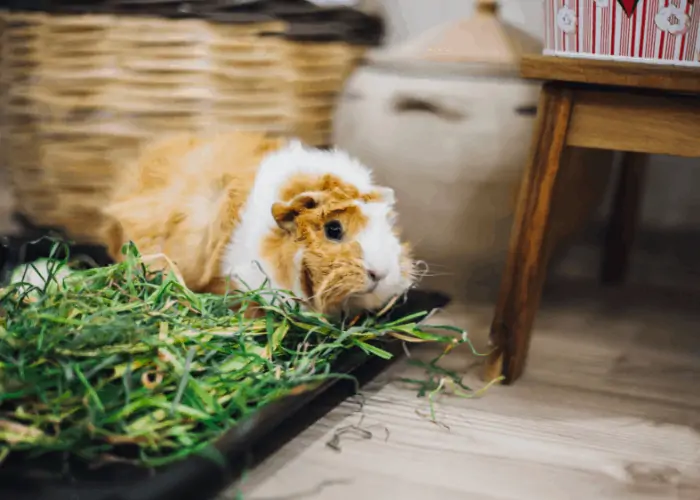
On top of these two essential components should be a cup of fruit and vegetables every day.
Guinea pigs can eat a wide range of things, but you should mix up what you give them so that they don’t get too much of one particular nutrient.
For example, spinach and kale are high in iron and can lead to blood disorders if given too frequently.
I give my guinea pigs about ¾ a cup of leafy greens and ¼ of chopped fruit or vegetables. Some of my favorites for regular feeding (by which I mean 2-3 times a week) are:
- Romaine lettuce
- Chicory
- Endive
- Lambs leaf lettuce
- Corn Husks
- Parsnip
- Tomatoes
- Red peppers
- Red cabbage
- Brocolli
There are plenty of other things your guinea pigs can eat, such as strawberries, bananas, spinach, and blueberries, but these should be fed in moderation.
By this I mean once or twice a week, any more than this and it could make your guinea pigs ill.
How To Feed Your Guinea Pigs A Balanced Diet
As I explained above, the majority of a guinea pig’s diet will be hay and pellets, but you should vary the type of fruits and vegetables you feed them to ensure they’re getting a good range of nutrients.
But how do you do this?
I’ve found the easiest way to keep track of my guinea pigs’ diet is to keep a food chart. I write down what I’ve fed them and when so I can be sure I’m not overfeeding on one type of vegetable.
There are plenty of templates available online, but I just keep track of mine on a whiteboard.
Obviously, most people will work on what they’ve got in the house, but keeping a chart is very useful.
Also, there’s no harm in going out and picking some dandelion leaves (providing they haven’t been sprayed with pesticides), but make sure you keep a log of these too.
Conclusion:
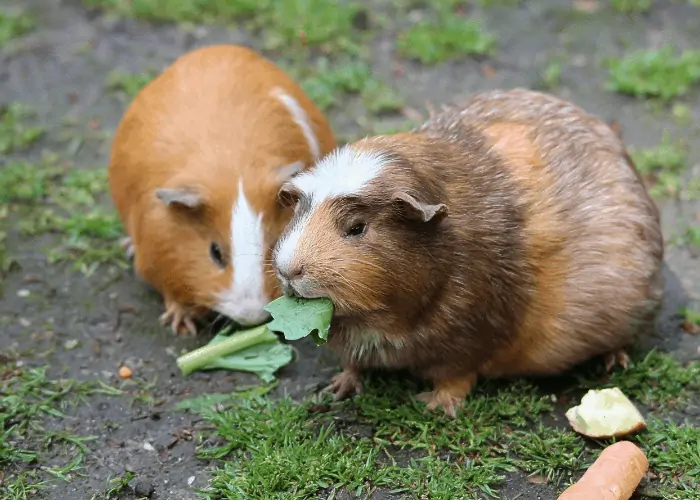
I found through my research that guinea pigs can eat a range of fruits and vegetables, but it’s best to give them a variety.
The main part of their diet should be made up of hay and a daily portion of guinea pig pellets. Be careful how much you feed your guinea pigs though; they’re very prone to obesity.
Related Questions:
1. Can guinea pigs eat grass?
Guinea pigs can eat grass, but it needs to be fresh. This is best done by simply putting them on the lawn for a few hours. Never feed them grass clippings because these can be poisonous.
2. Can guinea pigs eat apples?
Guinea pigs can eat apples, but they should be given in moderation. Apples are high in sugar, and this can make guinea pigs obese or cause diabetes.
3. Can guinea pigs eat cheese?
Guinea pigs can’t eat cheese, or any dairy for that matter. They don’t have the right digestive system for it and so it can make them really ill.

